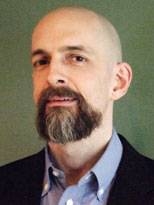Celebrated author Neal Stephenson, known primarily for his speculative fiction works, visited MIT Sunday to speak to fans and sign copies of his books, including his latest novel, "Anathem." MIT News Office correspondent Stephanie Schorow caught up with Stephenson ahead of his appearance and posed him a few questions by e-mail. Here are his responses:
Q: Do you see a relationship between the inspiration for science fiction/speculative fiction and actual science?
A: They play off of each other in a way that's pretty interesting. Each side provides ideas for the other.
Q: In preparing your fiction, how much (if at all) do you look into actual research into media, digital technology or other sciences? How about history?
A: Depends on the book. I haven't written a thing about modern technology in the last eight years or so, so haven't had to look into those topics very much. "The Baroque Cycle" and the World War II part of "Cryptonomicon" obviously required a lot of historical reading and the new novel, "Anathem," has quite a bit of philosophy and metaphysics, shading over into some fundamental physics questions such as the many worlds interpretation of quantum mechanics.
Q: Why do you think that aspects of your novels (such as the "Metaverse" in "Snow Crash") seem to "come true"?
A: In the case of the Metaverse, the answer is: because it's so obvious. A similar remark could be made of Google Earth.
Q: Was there any one idea or concept that inspired your new novel "Anathem"? Does it in any way reflect today's culture or politics? Or do you prefer the reader to decide that?
A: In general I prefer the reader to decide, but I don't want to be totally Sphinx-like and so I'll permit myself to say a little. As far as culture and politics are concerned, the important theme is long-attention-span vs. short-attention-span thinking. I'm sure that your readers can think of any number of ways in which having a longer attention span can be useful. But I'll name one. Bankers with long attention spans don't lend money to people who can't pay it back. If we had more bankers who adopted a long-term view of their responsibilities, we might not be in the middle of a financial crisis that is blowing away 150-year-old investment banks.
Q: Is there anything in your new novel (or the previous novels) that you would like MIT students to focus on as in "Hey, I could create THAT"? Or, conversely, for them to think, "Oh boy, I never realized the consequences of creating THAT."
A: It'd be a big impediment to my getting any work done if I were always sitting there thinking to myself "Hmm, I'd better not write that down in case some MIT student decides to implement it." Even worse would be if I somehow got the notion in my mind that I could lead us to a brighter future by playing Pied Piper to a lot of MIT students.
Having said that, "The Diamond Age" depicts some nasty consequences of molecular nanotechnology that it would be good to avoid, and so whenever I run into a molecular nanotech person I nag them to think about what kind of immune system we are going to have to engineer in order to protect ourselves from this kind of technology.
A version of this article appeared in MIT Tech Talk on September 24, 2008 (download PDF).






